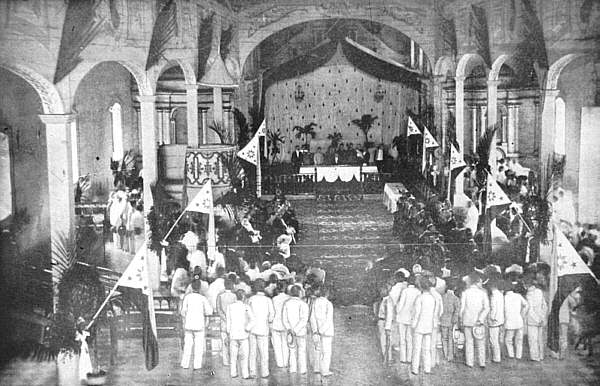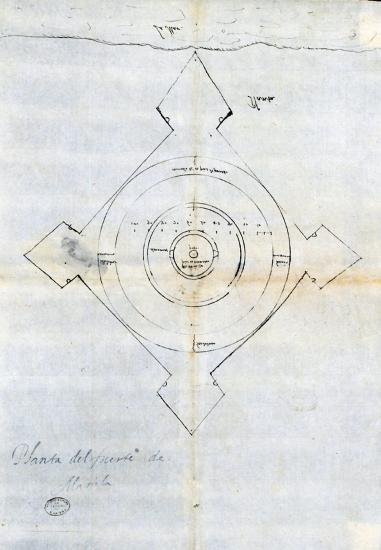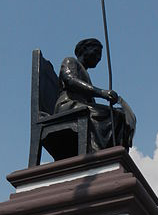|
Philippine Revolts Against Spain
During the History of the Philippines (1521–1898), Spanish colonial period in the Philippines, 1521–1898, there were several revolts against the Spanish colonial government by indigenous Moro people, Moro, Lumad, Indian people, Indians, Chinese Filipino, Chinese (Sangleys), and Insulares (Filipinos of full or near full Spanish descent), often with the goal of re-establishing the rights and powers that had traditionally belonged to Lumad communities, Maginoo Rajah, and Moro people, Moro Datus. Some revolts stemmed from land problems and this was largely the cause of the insurrections that transpired in the agricultural provinces of Batangas, Bulacan, Cavite, and Laguna. Natives also rebelled over unjust taxation and forced labor. Most of these revolts failed because the majority of the local population sided up with the well-armed colonial government, and to fight with Spanish as foot soldiers to put down the revolts. In Mindanao and Sulu, a Spanish–Moro conflict, contin ... [...More Info...] [...Related Items...] OR: [Wikipedia] [Google] [Baidu] |
History Of The Philippines (1521–1898)
Earliest hominin activity in the Philippine archipelago is dated back to at least 709,000 years ago. ''Homo luzonensis'', a species of archaic humans, was present on the island of Luzon at least 67,000 years ago. The earliest known anatomically modern human was from Tabon Caves in Palawan dating about 47,000 years. Negrito groups were the first inhabitants to settle in the prehistoric Philippines. By around 3000 BC, seafaring Austronesians, who form the majority of the current population, migrated southward from Taiwan. Scholars generally believe that these ethnic and social groups eventually developed into various settlements or polities with varying degrees of economic specialization, social stratification, and political organization. Some of these settlements (mostly those located on major river deltas) achieved such a scale of social complexity that some scholars believe they should be considered early states. This includes the predecessors of modern-day population centers ... [...More Info...] [...Related Items...] OR: [Wikipedia] [Google] [Baidu] |
Rajah Sulayman
Rajah Sulayman, sometimes referred to as Sulayman III (Sanskrit: स्ललैअह्, Arabic: سليمان, Abecedario: ''Suláimán'') (1558–1575), was the Rajah of Maynila, a fortified Tagalog Muslim polity on the southern half of the Pasig River delta, when a Spanish expedition arrived in the early 1570s. Sulayman – along with his co-ruler Rajah Matanda of Maynila and Lakan Dula, who ruled the neighboring polity of Tondo – was one of the three reigning monarchs during the Spanish conquest of the Port of Manila and the Pasig River delta. Spanish accounts describe him as the most aggressive of the three rulers – a characteristic chalked up to his youth relative to the other two rulers. He was the rajah in the Pasig River Delta era. His adoptive son, baptised Agustin de Legaspi upon conversion to Christianity, was proclaimed the paramount ruler of Tondo upon the death of Lakan Dula, but he along with most of Lakan Dula's sons and most of Sulayman's adoptive son ... [...More Info...] [...Related Items...] OR: [Wikipedia] [Google] [Baidu] |
Pampanga
Pampanga, officially the Province of Pampanga ( pam, Lalawigan ning Pampanga; tl, Lalawigan ng Pampanga ), is a province in the Central Luzon region of the Philippines. Lying on the northern shore of Manila Bay, Pampanga is bordered by Tarlac to the north, Nueva Ecija to the northeast, Bulacan to the east, the Manila Bay to the central-south, Bataan to the southwest and Zambales to the west. Its capital is the City of San Fernando. Angeles City is the largest LGU but while geographically within Pampanga, it is classified as a first-class, highly urbanized city and has been governed independently of the province since it received its charter in 1964. The name ''La Pampanga'' was given by the Spaniards, who encountered natives living along the banks (''pampáng'') of the Pampanga River. Its creation in 1571 makes it the first Spanish province on Luzon Island (Cebu in Visayas is older as it was founded by the Spaniards in 1565). The town of Villa de Bacolor in the province bri ... [...More Info...] [...Related Items...] OR: [Wikipedia] [Google] [Baidu] |
Bulacan
Bulacan, officially the Province of Bulacan ( tl, Lalawigan ng Bulacan), is a province in the Philippines located in the Central Luzon region. Its capital is the city of Malolos. Bulacan was established on August 15, 1578, and part of the Metro Luzon Urban Beltway Super Region. It has 569 barangays in 20 municipalities and four component cities (Baliuag, Malolos the provincial capital, Meycauayan, and San Jose del Monte). Bulacan is located immediately north of Metro Manila. Bordering Bulacan are the provinces of Pampanga to the west, Nueva Ecija to the north, Aurora and Quezon to the east, and Metro Manila and Rizal to the south. Bulacan also lies on the north-eastern shore of Manila Bay. In the 2020 census, Bulacan had a population of 3,708,890 people, the most populous in Central Luzon and the third most populous in the Philippines, after Cebu and Cavite. Bulacan's most populated city is San Jose del Monte, the most populated municipality is Santa Maria while the least po ... [...More Info...] [...Related Items...] OR: [Wikipedia] [Google] [Baidu] |
Manila
Manila ( , ; fil, Maynila, ), officially the City of Manila ( fil, Lungsod ng Maynila, ), is the capital of the Philippines, and its second-most populous city. It is highly urbanized and, as of 2019, was the world's most densely populated city proper. Manila is considered to be a global city and rated as an Alpha – City by Globalization and World Cities Research Network (GaWC). It was the first chartered city in the country, designated as such by the Philippine Commission Act 183 of July 31, 1901. It became autonomous with the passage of Republic Act No. 409, "The Revised Charter of the City of Manila", on June 18, 1949. Manila is considered to be part of the world's original set of global cities because its commercial networks were the first to extend across the Pacific Ocean and connect Asia with the Spanish Americas through the galleon trade; when this was accomplished, it marked the first time in world history that an uninterrupted chain of trade routes circling ... [...More Info...] [...Related Items...] OR: [Wikipedia] [Google] [Baidu] |
Tondo Conspiracy
The Tondo Conspiracy of 1587, popularly known as the Conspiracy of the Maginoos (Spanish: ''La Conspiración de las Maginoos''), also known as the Revolt of the Lakans, was a revolt planned by Tagalog nobles known as maginoos, led by Don Agustin de Legazpi of Tondo and his cousin Martin Pangan, to overthrow the Spanish government in the Philippines due to injustices against the Filipinos.Halili, M.C. Philippine History. Rex Bookstore, Inc., 2004. It was territorially one of the largest conspiracies against the Spanish rule next to the Katipunan. It ranged from provinces near Manila all the way to the Calamianes Islands near Palawan.Martinez, Manuel F. Assassinations & conspiracies : from Rajah Humabon to Imelda Marcos. Manila: Anvil Publishing, 2002. Legazpi sought help from a Japanese sea captain named Juan Gayo and asked for arms and warriors to fight alongside them in exchange for one-half of the tributes collected in the Philippines. They also requested help from places such a ... [...More Info...] [...Related Items...] OR: [Wikipedia] [Google] [Baidu] |
Santiago De Vera
Santiago de Vera was a native of Alcalá de Henares, Spain and the sixth Spanish governor of the Philippines, from May 16, 1584, until May 1590. Governorship Governor Gonzalo Ronquillo de Peñalosa and Domingo de Salazar, the first bishop of Manila, had requested the King of Spain to establish the Supreme Court of the Philippines then called the ''Audiencia'', to settle disputes between the Church and State. In 1584, three judges arrived from Mexico and started the justice court with De Vera serving as the chief justice. After the sudden death of Governor Peñalosa, Diego Ronquillo, his nephew became the governor ''ad interim'' but was later charged for defalcation in the trust of Peñalosa's estate and was sent back to Spain as a prisoner. As the chief justice of the court, Santiago de Vera succeeded as the governor of the islands on May 16, 1584. First houses of stone Following the great fire of Manila on March 19, 1583, which started during the wake of Governor Gonzalo ... [...More Info...] [...Related Items...] OR: [Wikipedia] [Google] [Baidu] |
Datu
''Datu'' is a title which denotes the rulers (variously described in historical accounts as chiefs, sovereign princes, and monarchs) of numerous indigenous peoples throughout the Philippine archipelago. The title is still used today, especially in Mindanao, Sulu and Palawan, but it was used much more extensively in early Philippine history, particularly in the regions of Central and Southern Luzon, the Visayas and Mindanao. It is a cognate of the title ''ratu'' in several other Austronesian languages. Overview In early Philippine history, datus and a small group of their close relatives formed the "apex stratum" of the traditional three-tier social hierarchy of lowland Philippine societies. Only a member of this birthright aristocracy (called "''maginoo''", "''nobleza''", "''maharlika''", or "''timagua''" by various early chroniclers) could become a datu; members of this elite could hope to become a datu by demonstrating prowess in war or exceptional leadership. In large c ... [...More Info...] [...Related Items...] OR: [Wikipedia] [Google] [Baidu] |
Encomenderos
The ''encomienda'' () was a Spanish labour system that rewarded conquerors with the labour of conquered non-Christian peoples. The labourers, in theory, were provided with benefits by the conquerors for whom they laboured, including military protection and education. The ''encomienda'' was first established in Spain following the Christian conquest of Moorish territories (known to Christians as the ''Reconquista''), and it was applied on a much larger scale during the Spanish colonization of the Americas and the Spanish Philippines. Conquered peoples were considered vassals of the Spanish monarch. The Crown awarded an ''encomienda'' as a grant to a particular individual. In the conquest era of the early sixteenth century, the grants were considered to be a monopoly on the labour of particular groups of indigenous peoples, held in perpetuity by the grant holder, called the ''encomendero''; following the New Laws of 1542, upon the death of the ''encomendero'', the encomienda en ... [...More Info...] [...Related Items...] OR: [Wikipedia] [Google] [Baidu] |
Kapampangan People
The Kapampangan people ( pam, Taung Kapampangan), Pampangueños or Pampangos, are the sixth largest ethnolinguistic group in the Philippines, numbering about 2,784,526 in 2010. They live mainly in the provinces of Pampanga, Bataan and Tarlac, as well as Bulacan, Nueva Ecija and Zambales. Overview The province of Pampanga is the traditional homeland of the Kapampangans. Once occupying a vast stretch of land that extended from Tondo to the rest of Central Luzon, huge chunks of territories were carved out of Pampanga so as to create the provinces of Bulacan, Bataan, Nueva Ecija, Aurora and Tarlac.Henson, Mariano A. 1965. ''The Province of Pampanga and Its Towns: A.D. 1300–1965''. 4th ed. revised. Angeles City: By the author. As a result, Kapampangans now populate a region that extends beyond the political boundaries of the small province of Pampanga. In the province of Tarlac, the indigenous population of Tarlac City and the municipalities of Bamban, Capas and Concepcion are ... [...More Info...] [...Related Items...] OR: [Wikipedia] [Google] [Baidu] |
Governor General Of The Philippines
The Governor-General of the Philippines (Spanish: ''Gobernador y Capitán General de Filipinas''; Filipino: ''Gobernador-Heneral ng Pilipinas/Kapitan Heneral ng Pilipinas''; Japanese: ) was the title of the government executive during the colonial period of the Philippines, governed by Mexico City and Madrid (1565–1898) and the United States (1898–1946), and briefly by Great Britain (1762–1764) and Japan (1942–1945). They were also the representative of the executive of the ruling power. On November 15, 1935, the Commonwealth of the Philippines was established as a transitional government to prepare the country for independence from American control. The governor-general was replaced by an elected Filipino " President of the Philippine Commonwealth", as the chief executive of the Philippines, taking over many of the duties of the Governor-General. The former American Governor-General then became known as the High Commissioner to the Philippines. From 1565 to 1898 ... [...More Info...] [...Related Items...] OR: [Wikipedia] [Google] [Baidu] |
Guido De Lavezaris
Guido de Lavezaris (c. 1512 – d. 1581) was the second Spanish Governor General of the Philippines. He succeeded Miguel López de Legazpi in 1572 as governor, and was succeeded by Francisco de Sande on August 25, 1575. Early life Little was known of Governor-General Lavezares. In 1543, he became a member of the Villalobos Expedition that traveled to the Philippines. He became the royal treasurer of the expedition during the navigation. Later on, he was one of several prisoners who escaped from a prison in Ambon Island when Villalobos' crew and ships were captured by the patrolling Portuguese. Morga, Antonio de. (2004). ''The Project Gutenberg Edition Book : History of the Philippine Islands - 1521 to the beginning of the XVII century''. Volume 1 and 2. Governorship During his governorship, he directed Legazpi's grandson Juan de Salcedo to go to the northern portion of Luzon together with some 100 Spanish soldiers and conquer the present-day Ilocos and establish Villa Fernan ... [...More Info...] [...Related Items...] OR: [Wikipedia] [Google] [Baidu] |






